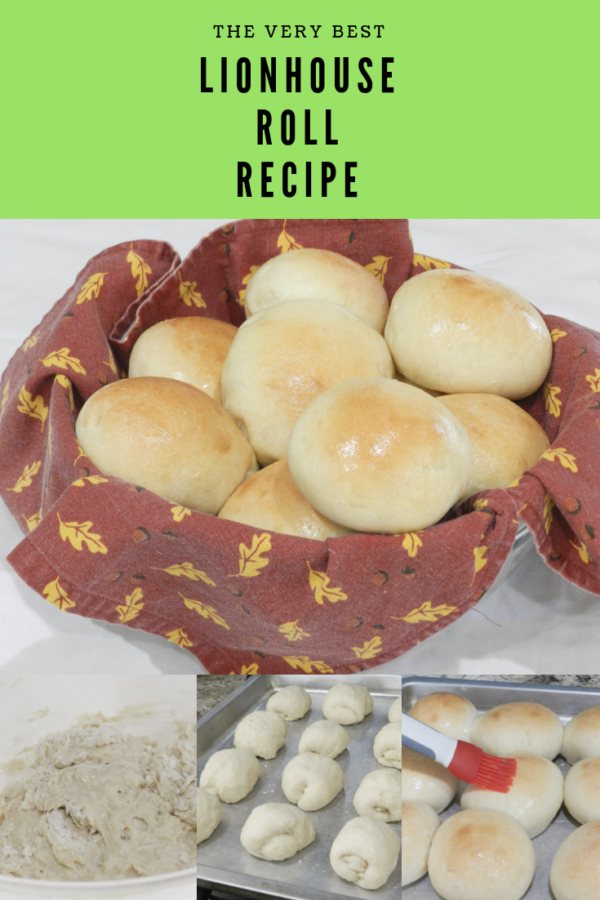
Disclaimer: This post contains affiliate links.
The holidays are not the holidays without homemade rolls. Growing up, my mom always made homemade rolls for our Thanksgiving and Christmas dinners. To buy them store-bought is nothing short of blasphemy in our family! Consequently, I am somewhat of a roll snob. Store bought or even frozen roll dough is just not acceptable in our family. At least not for the holidays.
My mom had a couple different recipes she’d use, but her Lionhouse Roll recipe was our favorite. If you’ve never heard of Lionhouse rolls, The Lionhouse is a very popular restaurant in Utah and they are known for their amazing rolls. Don’t ask me how my mom (or grandma) got ahold of this recipe; this was way before the days of Pinterest. But they got it and it’s been passed down through three generations now.
Speaking of Pinterest, I’ve seen lots of recipes for Lionhouse rolls over there, and they are all slightly different, so now I wonder what the “real” recipe really is. The biggest difference that I see between this and other recipes is that most of them call for dehydrated milk, rather than fresh milk. Fresh is always best, right? Whether this is officially it or not, I’m not really not sure (sadly, my mom and grandma are no longer here to ask!) But whatever recipe it is, it’s delicious! I’m glad that I learned the art of good roll making before my mom and grandma left this life.
This recipe is time-consuming; not so much the mixing part of it, but the rising part of it. It needs a total of 4 hours to rise. I suppose that’s why we only make them at the holidays! For those of you who follow me, you know I enjoy simplicity. But for the holidays, I go all out! Just make sure to plan ahead and give yourself enough time for the job. I usually make these a day ahead of time.
So let’s get started! Here’s what you need:

To start with, you need to scald your milk. If you don’t know how to scald milk, here’s a good video showing how it’s done. Don’t be intimidated if you’ve never scalded milk before; it’s pretty easy and it helps your rolls to be lighter and fluffier!

In a separate bowl, combine your butter (I recommend it be soft/room temperature), egg, sugar, and salt. Give it a good stir. Your butter might still be chunky but once you add the warm milk, it’ll melt.


While you are waiting for your milk to cool, activate the yeast. You do this by adding your yeast to 1 cup of water. The water should be warm enough that it activates the yeast, but not so hot that it kills it. Somewhere between 100-110 degrees is perfect. The yeast should look nice and foamy on top. Set it aside for a few minutes.
Just a note about yeast: if you store your yeast in the fridge or freezer like I do, make sure that it is at room temperature before you use it, otherwise it will be too cool to be activated. You would think that is common sense when working with yeast, but this girl right here didn’t think about that and I was wondering why my dough wasn’t rising as much as it should. Letting it sit out for about 20 minutes will insure that your dough rises nicely and your rolls be soft and fluffy!

When the milk has cooled, add it to your dough mixture and give it a good mix. Remember you have an egg in there, so if your milk is too hot, it will cook the egg and you’ll have bits of cooked egg in your dough. Gross. Be patient and let it cool to a warm temperature.

Once that is mixed, stir in 1 cup of your flour. Then, add your yeast mixture, giving it another good stir. Add the rest of your flour, one cup at a time.



At some point, it will become too thick to stir with the spoon. Ditch the spoon, flour up your hands, and knead the dough.

You will be adding between 6-7 cups of flour. Don’t over-flour it. This dough is meant to be a sticky dough; you don’t want it to be too dry.
Once the flour is worked in, roll it into a ball, put it in a bowl and cover it. Let it rise for 2 hours. It’s always best to let your dough rise in a warm place, free of draft.


After two hours, you are going to form your dough into rolls. Form your rolls by first rolling a piece of the dough into a ball. Next, flatten the ball in your hand, kind of pressing it to more of a squarish shape rather than a circle. Now, fold over the two sides, bringing one side across the other. Repeat the folding with the top and the bottom as well. So you end up folding over all four sides of the dough.




Place your rolls on a greased cookie sheet and cover them once again. You may want to add just a tiny bit of spray on top so that your towel doesn’t stick to them. Let them rise for another two hours.

In your last 20 minutes of rising, turn your oven on to 350. Once they are done rising, place in the oven and bake for 22-25 minutes, or until the tops are lightly golden brown. Take them out of the oven and brush the tops immediately with melted butter. On a side note, if you don’t have a silicone pastry brush, it’s a must-have in the kitchen! They are so much more sanitary than your normal “hair” material pastry brushes. They are easy to clean and they don’t shed. I love mine!

And there you go! The fluffiest, yummiest, homemade rolls! The best part of Thanksgiving!! I want to hear how yours turn out!



| Prep Time | 20-25 minutes |
| Cook Time | 22-25 minutes |
| Passive Time | 4 hours |
| Servings |
rolls
|
- 1 cup sugar
- 1 TB butter/shortening
- 1 cup scalded milk
- 1 egg
- 2 1/2 tsp. yeast (or 1 package)
- 1 tsp. salt
- 1 cup water
- 6-7 cups all-purpose flour
Ingredients
|
   |
- First, scald your milk. Once it's scalded, set it aside and let it cool to a warm temperature (you don't want it hotter than 100 degrees when adding it to the rest of the mixture).
- In a separate bowl, combine your butter (soft/room temperature), egg, sugar, and salt. Mix well.
- While you are waiting for your milk to cool, activate the yeast. Do this by adding yeast to 1 cup of water. The water should be warm enough that it activates the yeast, but not so hot that it kills it. Somewhere between 100-110 degrees is perfect. The yeast should look nice and foamy on top. Set aside for a few minutes.
- When the milk has cooled, add it to the dough mixture and stir thoroughly.
- Add 1 cup of the flour. Then, add the yeast mixture, mixing well. Add the rest of the flour, one cup at a time. When it becomes too thick to stir, knead the dough by hand. Add 6-7 cups of flour until it has a slightly sticky consistency. Do not add too much flour, or your dough will be dry.
- Roll dough into a ball and set it in a big bowl. Cover the bowl with a cloth and let it rise for 2 hours.
- After two hours of rising, form the dough into rolls. Form rolls by first rolling a piece of the dough into a ball. Next, flatten the ball in your hand, kind of pressing it to more of a squarish shape rather than a circle. Now, fold over the two sides, bringing one side across the other. Repeat the folding with the top and the bottom as well. You end up folding over all four sides of the dough.
- Place on a greased cookie sheet. Very lightly spray the top with a non-stick spray and cover the rolls with a towel. Let rolls rise for another 2 hours.
- During the last 20 minutes of rise time, heat your oven to 350.
- Bake the rolls for 22-25 minutes, until the tops are lightly golden brown.
- After removing from the oven, immediately brush the tops with melted butter.
- Enjoy fresh out the of the oven, or store in a container for up to a week.

